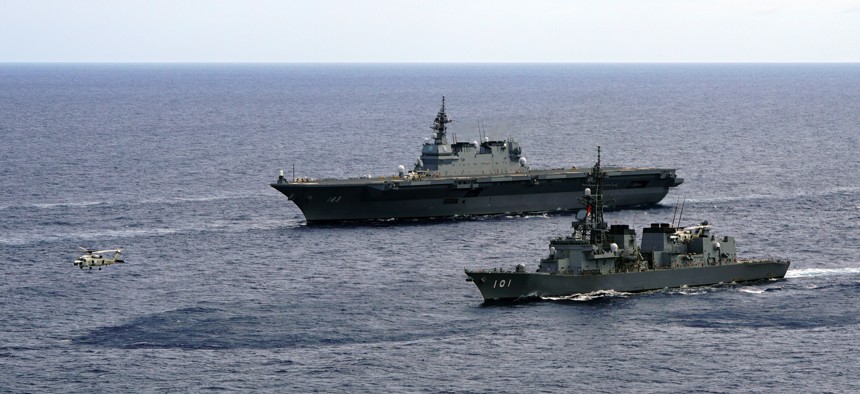
In this June 28, 2019, photo, Japan's Maritime Self-Defense Force helicopter carrier Izumo (DDH-183) and destroyer JS Murasame (DD-101) participate in drills that included maritime navigation and emergency response exercises in Sulu Sea. AP / Emily Wang
Don’t Demand Protection Money from Japan. Do Ask Tokyo to Rethink Its Defenses
A well-fortified Japan could take the lead in its own security, with U.S. forces acting as a backstop rather than the primary combatants.
As part of the Trump administration’s efforts to persuade allies to pay more for U.S.-provided defense, American officials reportedly asked Japan to quadruple its annual payments to support the 54,000 U.S. troops stationed there—to $8 billion. Perhaps this was a negotiating tactic meant to shake complacent allies into boosting their own defense budgets, but security burden-sharing is not a monetary issue of balancing ledgers between nations. A much more valuable—and realistic—goal for the U.S. would be pushing Japan to spend the extra $6 billion to expand its military capabilities, making it a stronger and more reliable security partner.
More than any other U.S. ally, Japan is in a position to deter Chinese military aggression, something much of Washington fears. As the world’s third-largest economy, a hub for advanced technology and manufacturing, and a country that straddles choke points for the Chinese navy, Japan can develop better defensive capabilities to balance Beijing’s military power.
While decades of steadfast U.S. commitment to allied security has encouraged many allies to let their militaries atrophy—a trend most pronounced among the members of NATO Europe—Japan maintains an effective, modern military. These Self-Defense Forces are far smaller than China’s People’s Liberation Army, with the PLA fielding nearly ten times as many active duty troops, twice the aircraft, and five times the naval assets. But the SDF is qualitatively superior, particularly in warships, fighter jets, and submarines.
Related: The Biggest Winner Of the Japan-South Korea Dispute? China
Related: Dear Pope Francis: While You're in Japan, Call for No First Use
Related: Great Power Competition Spurs Arms Purchases By Smaller Asian Countries
Japan’s military budgets, however, have largely gone toward building a “forward defense,” in which its air and naval forces would engage a Chinese incursion on the edge of its territory. This strategy is costly and unsustainable. Tokyo might have chosen to focus its spending on more cost-effective defenses of its coastline and islands, but instead pushed its military further afield, where its advantages fade and China’s vastly higher military spending produces clear superiority.
Japan could much more effectively secure the Japanese home islands by investing additional resources into a “defensive defense” operational concept, one that would expand anti-access/area-denial (A2/AD) capabilities enough to render its territorial waters and skies effectively inaccessible to Chinese forces. Defenders’ traditional advantage in warfare has been buttressed by recent advances in technology that allow them to cheaply counter expensive offensive ships and aircraft. Japan’s favorable geography, which forces a would-be conqueror to cross a large body of water, enhances this advantage.
Such a shift would leave the defensive orientation of Japan’s military unaffected—indeed this approach would be more consistent with a defensive strategy—but it would commit additional resources to more effectively achieving the goal of territorial integrity against aggression.
Japan’s military capabilities can be improved in a number of ways. Tokyo could expand its submarine fleet, add fleet defenses to protect its surface ships from Chinese ballistic missiles, and expand its network of sensors both in the Ryukyu Islands and the Japanese home islands. Japan can also grow its fleet of truck-mobile anti-ship ballistic missiles and better integrate them with surveillance systems. Japan currently lacks enough anti-missile and anti-aircraft munitions to fight an extended campaign and would benefit from a larger stockpile.
The United States would also benefits from a better-defended Japan. Current U.S. doctrine would have U.S. forces act as the first line of defense in the event of Chinese aggression against Japan. But a well-fortified Japan could take the lead in its own security, with U.S. forces acting as a backstop rather than the primary combatants. This is how a traditional alliance functions, and a transition to that model is a far more valuable contribution to U.S. security interests than a higher Japanese contribution to station U.S. forces.
The time is right for Japan to reinvigorate its defensive capabilities, with America’s blessing. The U.S. is overstretched and poorly-positioned to secure all U.S. allies in Asia, even if it does eventually wind down costly commitments in the Middle East. Simultaneously, Japan has awakened to what China’s growing power might mean for its future—for the first time, China has replaced North Korea as the top threat in Japan’s annual defense review. Under Prime Minister Shinzo Abe, the nation has also undergone its first military expansion in decades, shedding a policy limiting military spending to 1 percent of GDP and seeking to amend the constitution so the SDF can be converted into a traditional military.
The U.S. and Japan are set to renegotiate the agreement governing U.S. forces in Japan early next year, and the U.S. can achieve its goals of more equitable burden sharing by pushing Japan to invest more, and more intelligently, in its own defense. In addition to easing the U.S. burden for Japan’s security, this conveniently aligns with the political objectives of Japan’s leaders and would be far easier to stomach for Japan’s public than a bigger direct payout to the U.S.



